Theme and Concept
8th Yokohama Triennale “Wild Grass: Our Lives”
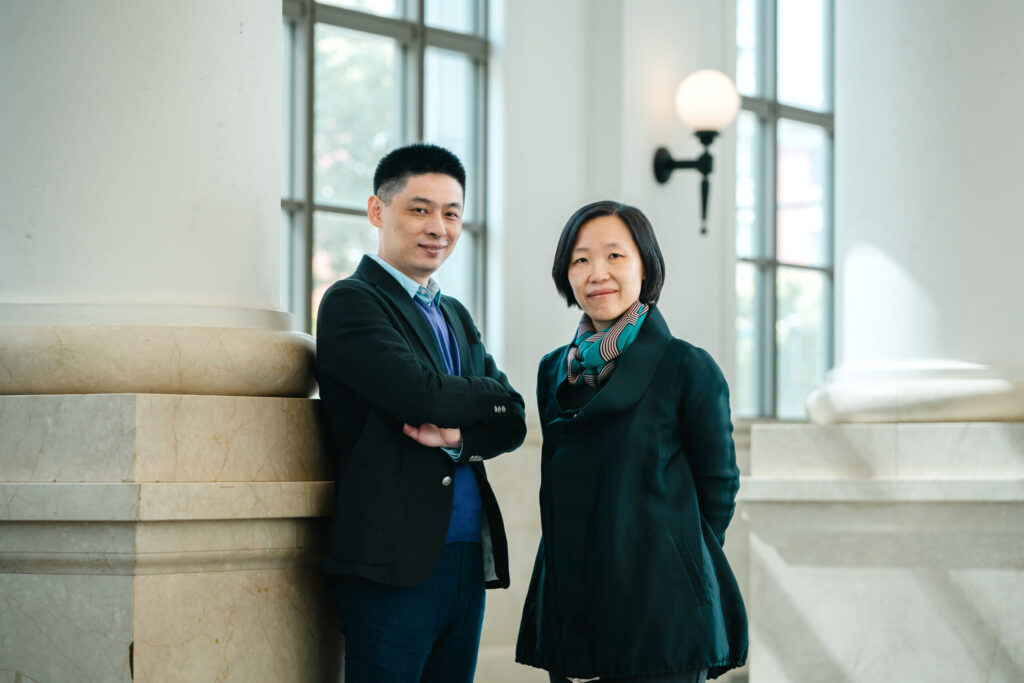
Wild Grass: Our Lives was conceived at the end of 2021 as an exhibition theme for the 8th Yokohama Triennale. It was a time when the world gradually emerged out of COVID-19 pandemic, restarting and reconnecting. The preparation for the 8th Yokohama Triennale was part of this worldwide recovery, with an aspiration to set new standards, to distinguish itself among the 250 or so biennales and triennales that are held around the world today. This ambitious and courageous initiative exudes the light of hope. This light shoots out of a backdrop of devastation, desperation, and a profound sense of crisis brought about by the pandemic, climate change, the widespread turn towards conservative nationalism and authoritarianism, the Russian war in Ukraine, the rise of conspiracy theories in popular consciousness, and other multitudes of adversities. We were inspired to search for an exhibition theme that speaks of humble humanism, courage, resilience, faith, and solidarity.
This title is taken from the Chinese writer Lu Xun’s (1881‒1936) anthology Wild Grass, penned from 1924 to 1926, during a turbulent period in Chinese history. Its 23 essays portrayed the personal and social realities that confronted him. For Lu Xun, the greatest sense of crisis and defeat came from the 1911 Xinhai Revolution. It overthrew the Qing government, which represented the old order. Yet the new order that formed in its place did not bring about fundamental changes to society. He soon embraced the idea of taking despair, instead of hope, as the starting point for his life, work, and thoughts. He fully accepted the fact that there would be no more hope or ambition, only darkness, darkness. At the same time, he devoted himself to finding an outlet in this complete darkness. In 20th century China, Lu Xun was a singularly solitary individual who constantly rebelled against existing situations and simultaneously a thinker who stayed attentive to the movements of the world, contemplating the fate of individuals and humanity within them.
The exhibition theme Wild Grass: Our Lives aspires to Lu Xun’s philosophy of the universe and life. It doesn’t just call to mind the image of a fragile and defenseless existence, inconspicuous and alone, in the wilderness, with nothing to fall back on. It is also a symbol of a life force that’s unregulated, irrepressible, defiant, self-motivated, and prepared to fight alone at all times. Furthermore, there is no ultimate state of existence to arrive at. Every state of being is a mediation and a process in itself, where there is no victory or failure but only a perpetual state of internal movement. Thus, every state of being is potentially a messenger for each other, mediating for each other. These philosophical propositions are not abstract; they exist vividly in the world of experience, and are the experiences themselves. Wild Grass signifies a philosophy of life that elevates their repressible force of individual life to a respectable existence that transcends all systems, rules, regulations, and forms of control and power. It is a model for flexible expression of subjectivity.
The rapid global spread of the novel coronavirus, which began in 2019, has led us to consider the irreconcilable contradictions brought about by globalization. Pandemics have prompted, accelerated, and even triggered new crises to surface, not only in public health, but in other crises as well. In the context of a pandemic, geopolitical, economic, and social challenges intertwined, highlighting the contradiction between old languages and new historical conditions, rooted in the political and social structures and mechanisms of the 20th century. The contemporary world order was formed after the decline of socialist institutions and the end of the Cold War. The most pressing issue facing the various political systems today is the disconnect that exists between them and their social forms. Inequitable distribution systems and oligarchic economic monopolies have led to a constant division and immobilization of social classes and strata, so that individuals can no longer find expression for themselves at the political level. We are stuck in the logic and oppression of the existing society, even though we want to get out of this predicament. These experiences have not only revealed the fragility of mankind, but also the limitations of 20th century political and social institutional design.
The mix of political hegemony, escalating ideological competition, and clashes of civilizations exerts an ongoing corrosive and destructive effect on the well-being of the contemporary world. The space for individual existence has been severely compromised and overwhelmed. The fight for equality and democracy remains relevant and even more urgent today. It is, therefore, a principle of ethics to reaffirm the meaning of the individual in the depth of history, as opposed to the history of the successful and powerful, and in contemporary society. Research around ordinary people and their lives can provide a stable and solid structure in the face of the complexities and challenges of constant change. However, the individual should not be an abstract concept that is inherently exempted from moral responsibility in the face of public events. We propose a modest imaginary where we are all outsiders living in the cracks, often stealthily dismantling the systems that are killing us.
In the 8th Yokohama Triennale, we wish to revisit a selection of historical moments, events, figures, and trends of thoughts since the beginning of the 20th century. Some examples include the resonance of Japanese and Chinese left wing wood cut movements in the early 1930s, the rise of subjective imaginary in the postwar cultural construction in East Asia, the reflection on modernity after the global radical movements of the late 1960s, and the critical and emancipatory energy of postmodernism in full swing in the 1980s. On this basis, we draw inspiration from the anarchist practices and thoughts that have emerged since the proposal of the end of history, to explore options for possible dialogue between individuals and established rules, and institutions.
In this Triennale, we prioritize the relationship between art and its intellectual underpinnings and champion the engagement of art with reality. We hope to generate a new imaginary of global friendship in the name of art, and call for the promising union of the spirit of individual internationalism and weak signals.
Liu Ding and Carol Ying hua Lu
ArtisticDirectors 8th Yokohama Triennale
Profile

LIU Ding
Liu Ding is an artist and a curator. Born 1976 in Changzhou City, Jiangsu Province and now based in Beijing. He creates artworks using text, photography, installation, painting, performance and other media based on his research into the interplay between art, culture, and politics in modern and contemporary Chinese history. His recent solo exhibition includes “Reef: A prequel,” Bonnefanten, Maastricht (2015). He’s participated in biennales including Busan Biennale (2018), Yinchuan Biennale (2018), Istanbul Biennial (2015), Asia Pacific Triennial (2015), Prospect 3 New Orleans(2014), Shanghai Biennale (2014), Taipei Biennial (2012), ChinesePavilion, 53rd Venice Biennial (2009), Media City Seoul (2008) and Guangzhou Triennale (2005). He’s participated in major groupshows including “DiscordantHarmony,” Art Sonje Center, Seoul / Hiroshima City Museum of Contemporary Art / Kuandu Museum of Fine Arts, Taipei (2015-16); “By Artists: From the Home to the Museum, from the Museum to the Home. Homages to theWorks of the Cerruti Collection,” Castello di Rivoli (2019) and “Parapolitics: Cultural Freedom and the Cold War, ”HKWBerlin(2018). In 2015, he joined Tate’s online festival “BMW Performance Room” in London.

Carol Yinghua LU
Carol Yinghua Lu is an art historian and a curator. Born 1977 in Chaozhou City, Guangdong Province and now based in Beijing. She is Director of Beijing Inside-Out Art Museum, where she’s recently curated “WangYoushen: CodesofCulture” (2022). She was Artistic Director and Chief Curator of OCAT, Shenzhen (2012-2015) and Co Artistic Director of Gwangju Biennale (2012). She was a contributing editor for frieze magazine (2008-2018), a recipient of ARIAH East Asia Fellowship(2017) and visiting fellow in Asia-Pacific Fellowship Program at Tate Research Centre(2013). She has acted as a jury member for many art prizes, such as Tokyo Contemporary Art Award(20192022), Rolex Mentor and Protégé Arts Initiative (2019), Hugo Boss Asia (2019), International Award for Art Criticism(2014), Future Generation Art Prize (2012), and Golden Lion Award at Venice Biennale(2011).
Exhibition highlight
Since the end of 2019, our lives, minds, bodies, and livelihoods have been subject to challenges and tests. Predicaments have become more and more pronounced against the backdrop of the fading epidemic. As creative practitioners, we feel the need to express today’s experience through an artistic approach. We hope to compose a Wild Grass for today in this edition of Yokohama Triennial. To do so, we invite artists, thinkers, scholars, and social activists to join us and participate in the development of the exhibition. When it comes to collaborating with artists, we basically combine our knowledge of Chinese and Japanese art history with our insights into the global contemporary art world. We choose to work with artists who have deep-rooted engagements with their specific local realities and histories, which give dynamism to their art practice. We select existing works by artists and collaborate on new commissions with artists who have the potential to resonate with this topic while having the ability to express their views through their artworks. We hope this exhibition can impersonate the complex reality of the current moment through artistic creations.
The 8th Yokohama Triennial will take place in three exhibition venues, as well as a number of outdoor public spaces. The main exhibition venue is the Yokohama Museum of Art. Here, the exhibition will begin with the first section, “Our Lives, ” which will take the form of an expanded camp site. As a visual prelude to the exhibition, it will present to the viewer various states of exception, which we don’t usually notice all the time, but are deeply embedded in our reality – refuge, exile, wandering, protest, wartime, post-disaster, happy reunion. These are social landscapes that are completely parallel to our life experiences, in which thousands of people are living. Each one of us may be subject to the same conditions at any time. Here, the states of emergency and precarious existences are considered as the everyday norm, as opposed to exceptions. In a way, it is a philosophical hypothesis. Yet in the meantime, we must realize that it is nothing short of our common reality. This section also sets the tone of the entire exhibition, confronting our crisisridden reality while emphasizing the resilience and agency of the individual in the face of despair. It will be a landscape where multiple challenges are intertwined with a disorganized yet irrepressible force of life.
In this chapter, at the heart of the Grand Gallery, we will install a reading table and present a “Directory of Life.” It is a selection of essays by artists, thinkers, and social activists who have been reflecting on our time, history, and life in their own specific situations since 2000. Their writings outline the political, intellectual, and cultural energies that lurk in everyday life. These practices and ideas allow us to imagine a utopia in our own historical situation. They call on us to discover and create from the smallest details of our own lives the relationships and non-relationships, the possibilities and impossibilities of communication that can change the whole situation. We hope that these texts will plant the seeds of action and hope in the hearts of every audience.
Having opened with Our Lives, giving a picture of our real states of living, Wild Grass moves on to My Liberation and All the Rivers, two chapters, which look at subjective agencies, attempts, imaginaries and actions to create horizons of possibilities for individuals within confining systems. Three remaining chapters, Streams and Rocks, Dialogue with the Mirror, and Fires in the Woods align with these promising horizons by highlighting symbolic power of youth, awakened self and cracks in flows of life. Symbol of Angst echoes Our Lives through a profound critique of modernity. Throughout the exhibition, we keep pointing out the correlation between art and the reality and the importance of ongoing and critical engagements with life and the society for artistic practitioners. In a way, this is a critical response to the fact that the capitalization of art and the logic of art industry have overtaken the art world everywhere, which seriously jeopardize the intellectual capacity and critical agency of art.
To conclude, we imagine the making of the entire Triennale as composing a symphony from several aspects. On the one hand, we revisit several instances of individuals exploring possible ways of spiritual and cognitive self-constructions during the modern history in East Asia. As such, we hope to ignite people’s desires and efforts to discover and recognize their own agency in our contemporary lives. On the other hand, we promote a sense of urgency in encountering our times and reconstructing the relevance of the individual in driving changes in this world. We do so by presenting works involving engagements from personal perspectives of the present with today’s cultural and political landscapes. At the same time, we will portray some of the theoretical references and practical approaches of activist movements in East Asia since 2000, which have helped alleviate the plight of the subjects under the statute of modernity. We lay out these aspects as ways of selfemancipations while facing up to the status quo of the individual who is constantly being regulated, weakened, and inhibited in the contemporary order of life. We hope to inspire people to actively discover ways of living beyond what is prescribed to us by the current system, to think and explore worlds outside of existing boundaries, limits and orders of things
In the exhibition, we will present both historical case studies and contemporary practices. Through them, we hope to think with our audience about how to activate the agency and power of the individual in our current lives, to form international friendships on a personal level that transcend ideological boundaries and national borders, to form a world centered on living people. The stress on individual agency is not about denying the relevance of collectivity, but about a kind of multitude consisting of active individual subjects coming together.
- Directory of Life
-
Fellow thinkers and sources (published year in the original language)
Karatani Kōjin, Principles of the New Associationist Movement (NAM), 2001 (2000)
Wang Hui, “Let Us Ask Again: Equality Of What?,” 2016 (2011)
David Graeber, “On the Phenomenon of Bullshit Jobs: A Work Rant, ” 2013
Judith Butler, Notes Toward a Performative Theory of Assembly, 2015
Björk & Timothy Morton, “Björk’s Letters with Timothy Morton, ” 2015
Matsumoto Hajime, Manual for a Worldwide Manuke Revolt, 2021 (2016)
Mckenzie Wark, Capital Is Dead: Is This Something Worse?, 2019
Saito Kohei, Slow Down: How Degrowth Communism Can Save the Earth, 2024 (2020)
Anonymous, the Tangpingist Manifesto, 2022 (2022)
Ingo Niermann & Erik Niedling, the Walder Diet, 2024 - Chapters
-
Our Lives
My Liberation
All the Rivers
Streams and Rocks
Dialogue with the Mirror
Fires in the Woods
Symbol of Depression - Thinking Partners
-
Egami Kenichiro, Assistant Professor, Tokyo University of the Arts
Hagiwara Hiroko, Emeritus Professor of Osaka Prefecture University
Machimura Haruka, Curator, Machida City Museum of Graphic Arts
Wang Qin, Associate Professor, College of Arts and Sciences, The University of Tokyo
Yamamoto Hiroki, Lecturer at Kanazawa College of ArtAlphabetical order by Last name.
- Architect Team
-
nmstudio architects + HIGURE17-15 cas
- Visual Identity
-
REFLECTA, Inc. (OKAZAKI Mariko + TAOKA Misako + TANAKA WETLI Minami + SHAO Qi)
Our Lives
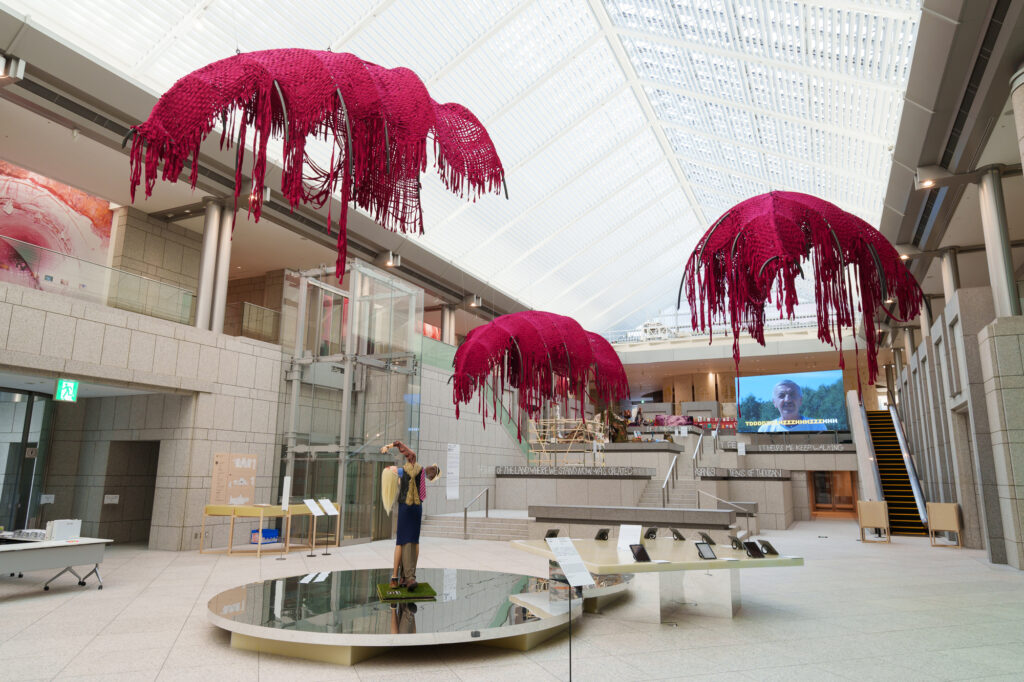
Sandra MUJINGA, And My Body Carried All of You, 2024/Pippa GARNER, Human Prototype, 2020, Courtesy of the Artist and STARS, Los Angeles
The large space at the start of the exhibition is somewhat reminiscent of a camp. It looks like a campground surrounded by nature or a refugee camp where people huddle together.
Caught in disasters and wars, evacuated, fleeing, and wandering――these “emergencies” are right at our doorstep. Countless people live in refugee camps and other harsh environments. We are all equally subject to unexpected and extraordinary situations, even as we go about our daily lives without thinking about them.
The works of the artists introduced in this chapter symbolically represent such crises. They give us clues to help us imagine the emergencies that may one day come. However, it is precisely at times like these, when our very safety is threatened and we are yearning to survive, that our creative power is stimulated and the possibilities of life are opened wide.
On a table in the center of the room is the Directory of Life. It is a collection of writings by artists, thinkers, social activists, and others since the 2000s about the current era, history, and life. These writings urge us not to stand idly by, but to put their ideas into practice.
Fires in the Woods
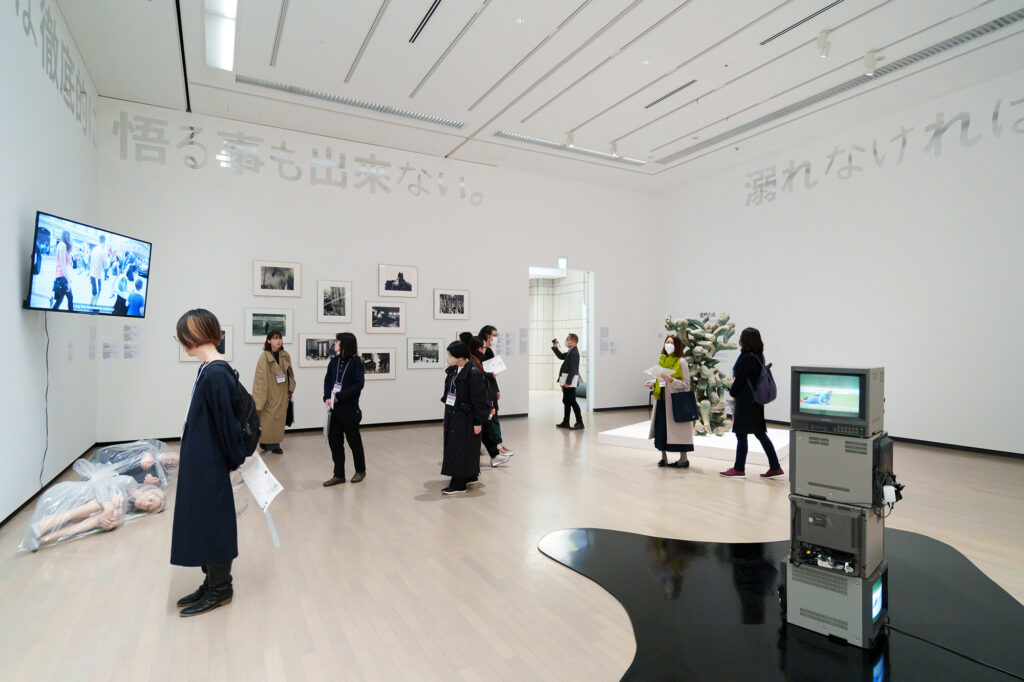
HAMAGUCHI Takashi, from Student Protests Against the 1970 Security Treaty Renewal, Yokohama Museum of Art/KURIYAGAWA Hakuson, from Leaving the Ivory Tower, published in 1920/TESHIGAHARA Sofu, Title Unknown, 1963, Sogetsu Foundation/Tomas RAFA, Video V65: Far right Identitarians protest against refugees, 2016, Courtesy of Tomas Rafa/Josh KLINE, Thank you for your years of service (Joann / Lawyer) (foreground), Wrapping Things Up (Tom / Administrator) (background), 2016, Fondazione Sandretto Re Rebaudengo/Pope.L, The Great White Way, 22 miles, 5 years, 1 street (Segment #1: December 29, 2001) , 2001-2006/2024, Courtesy of the Artist and Mitchell-Innes & Nash, New York
In this chapter, we look at history as a reflection of the present. It brings back moments in history when sparks flew as fiercely as when flint was struck.
Fires and sparks are metaphors for conflicts, confrontations, clashes, and incidents. In this room, works that reflect on such historical events are displayed together with those that address the issues of today. In this way, the past and the present are blended and the differences between eras disappear. The suffering of people and their actions to cope with it instead emerge as the essence of life.
The works in this chapter were created by different artists, of course. But they are also the results of artists reacting to reality with a perspective common to all humanity. That is why they transcend the time and space in which the individual artists lived, and evoke empathy and resonance in us living in the present.
My Liberation
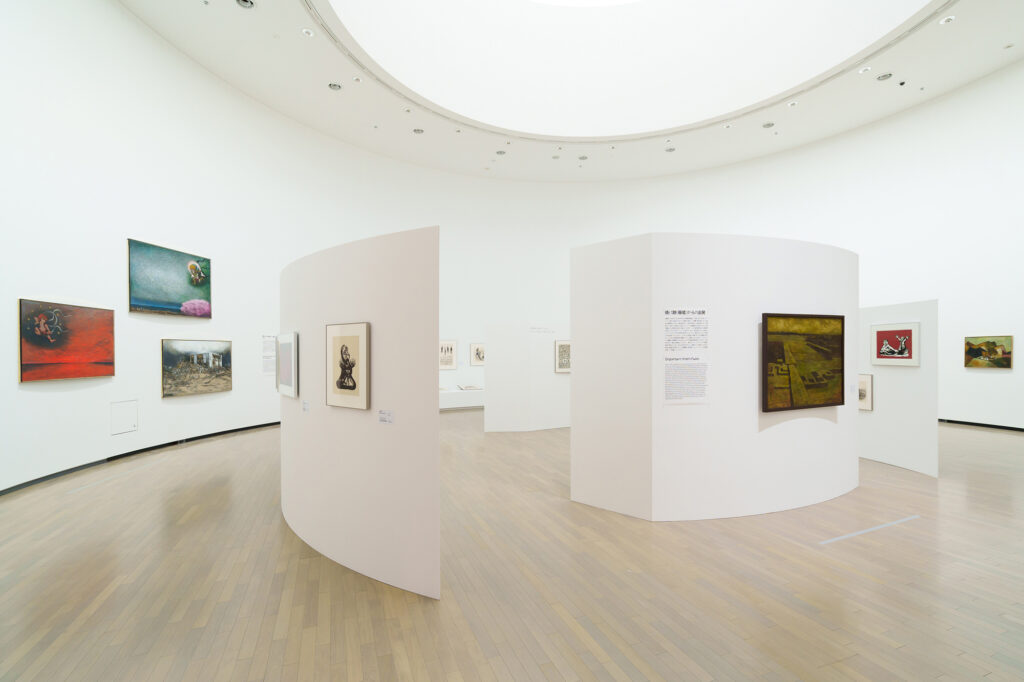
TOMIYAMA Taeko
This chapter is divided between Gallery 2 and Gallery 5. The title comes from the Japanese artist TOMIYAMA Taeko’s autobiographical essay My Liberation: Journey to the Frontier and the Bottom(1972).
In Gallery 5, we look back on the course of creation by TOMIYAMA Taeko.
TOMIYAMA grew up in the former Japanese colony of Manchuria and moved to Tokyo to become a painter. However, the China-Japan War deepened, and she spent her youth amidst the ravages of war. After experiencing the horrors of war and the starvation caused by postwar food shortages, she eventually began creating paintings about miners. In the early 1960s, after losing a labor dispute, many of those who worked in the mines emigrated to South America, and TOMIYAMA followed them on a journey through Latin America. Later, she visited the former Soviet Union, Europe, the Middle East, India, and South Korea, and became aware of the inequalities and injustices that were spreading throughout the world. irough her practice as an artist and social activist, TOMIYAMA strove to take Japan’s role to other Asian countries upon herself, as part of her individual responsibility.
Accepting major historical issues as part of our own responsibility――this attitude enables us to act instead of just thinking. This is an important theme running through the chapter “My Liberation.”
Streams and Rocks
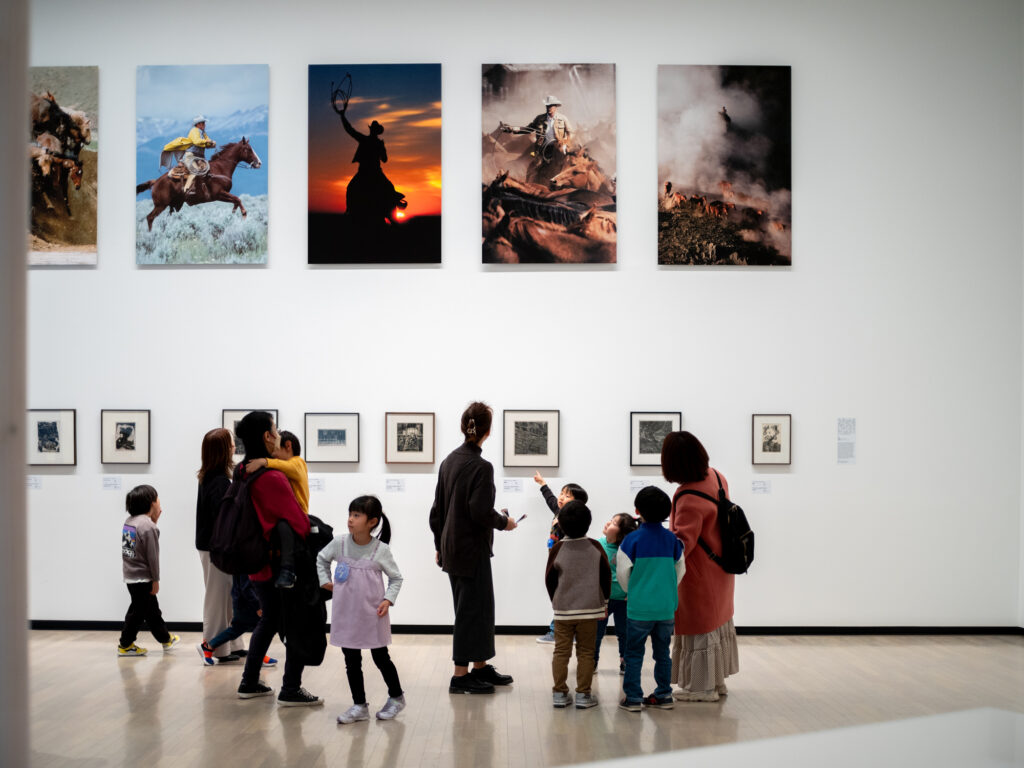
Norm Clasen, Treiborlang Lyngdoh Mawlong
In the chapter “Streams and Rocks,” we are introduced to the outpouring of life force in the clash between advancing and thwarting.
A stream is the constant vitality of life, a kind of latent energy that wells up. A rock, on the other hand, is like a difficulty, a stagnation, a problem that stubbornly stands in the way. When the flow hits a rock, it is blocked from moving forward, but at the same time, it creates energy there.
If we keep moving forward, the rock will eventually be scraped smooth and the flow will hit another rock. Interruptions and dead ends can break the continuity of meaning, but also create new meaning. Crisis and recovery always go hand in hand. In this sense, “Streams and Rocks” is a portrait of life as it is usually lived.
In this chapter, we focus on innocence, youth, carefreeness, exuberance, explosions, desire, serenity, mediocrity, and perseverance as signs of an effervescent life force. We then examine how these elements exercise their power on historical and contemporary issues. Youth, which never withers, is the source of the will to face challenges.
Symbol of Depression
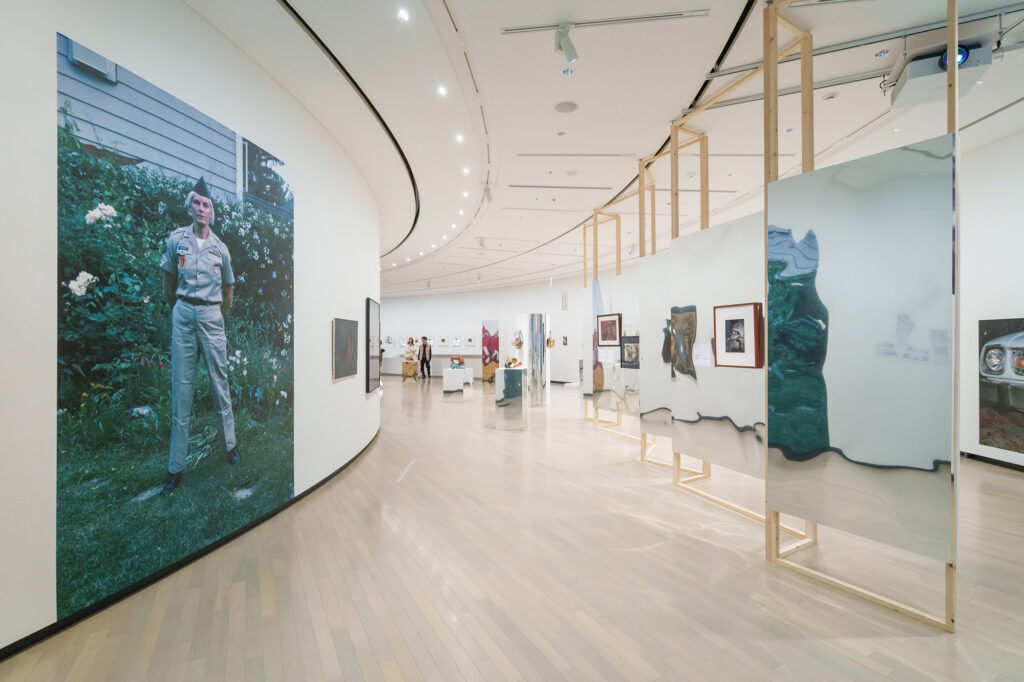
Pippa GARNER, Un(tit)led (Self-Portrait in Military Uniform), 1997/2024 print, Courtesy of the Artist and STARS, Los Angeles
This chapter takes us back in time about 100 years. The title is taken from a book Symbol of Depression(1924)by the Japanese writer KURIYAGAWA Hakuson, who was active between 1900 and the 1920s. In 1924, while writing his poetry collection Wild Grass, LU Xun simultaneously translated this book by KURIYAGAWA. In it, KURIYAGAWA wrote:
“Literature is the pure expression of life. It is the only world where one can express one’s individuality in a state of absolute freedom, completely free from the oppression and compulsion of the outside world.” *
However, KURIYAGAWA goes on to say that this freedom of creation does not come from a place where there are no restrictions, but from one where the forces that advance clash with the forces that restrain. In this sense, art is the “expression of depression” that arises from the struggle against “oppression and compulsion.” ie antagonism between these two forces is not limited to the creation of art; it may be a universal condition for the outpouring of the power of our lives to open up the future.
LU Xun studied in Japan in 1902, then abandoned his medical career to become a writer.
Upon his return to China, he used prints to promote modern ideas among the people. LU Xun’s collection of prints included works by Käthe KOLLWITZ, a printmaker who worked in sympathy with the German socialist movement.
* KURIYAGAWA Hakuson, Symbol of Depression, 1924, Kaizosha.
Dialogue with the Mirror
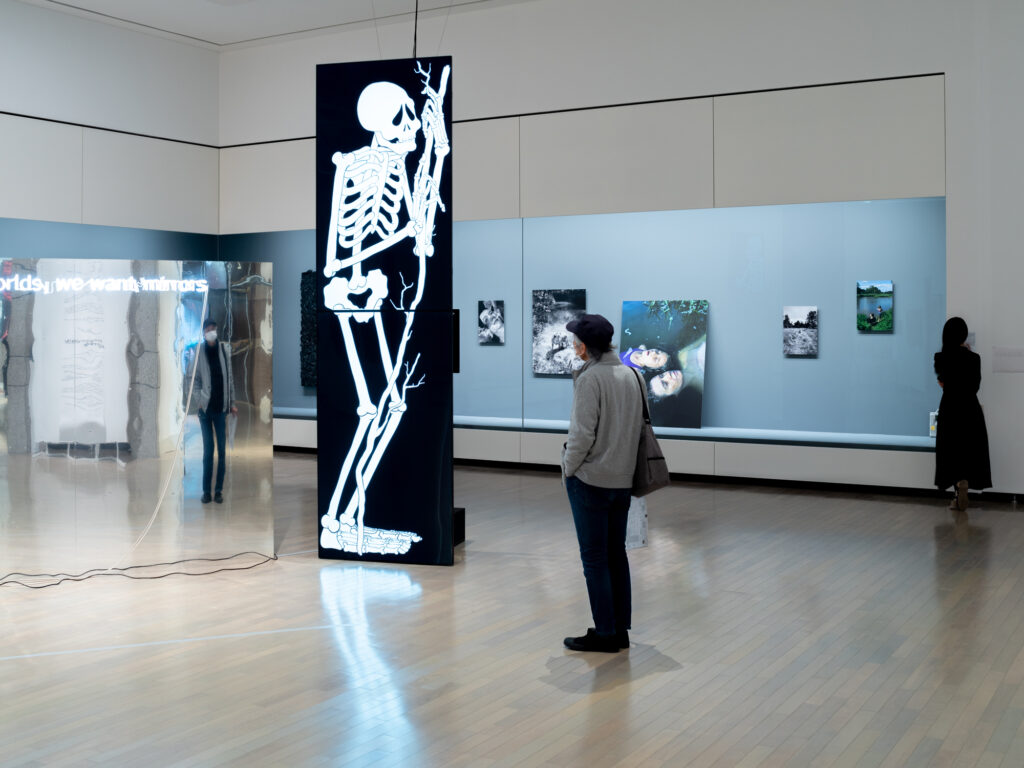
Özgür KAR, Death with Branch (from DAWN), 2023/Raffaella CRISPINO, We don’t want other worlds, we want mirrors, 2013, Collection of the Artist/Aneta GRZESZYKOWSKA, From MAMA and DOMESTIC ANIMALS, Courtesy of the Artist, Raster Gallery, Lyles and King Gallery
There is a curious passage in LU Xun’s collection of poems Wild Grass.
“From my backyard, I can see two trees outside the fence. One is a date tree. the other is also a date tree.” *
Why did LU Xun write in this way instead of “there are two date trees”? It is as if one thing is separated into two and they are facing each other. I wonder if that is what he was thinking.
A work of art is a mental self-portrait of the artist. It reflects the artist’s image like a mirror. At the same time, however, once created, a work of art appears before the artist as an independent entity.
One artist enters history, another transforms oneself into a machine. Through these actions, the artists look into their souls and search for secret passages to know themselves. The techniques used are observation, sketching, exaggeration, imagination, analogy, displacement, and symbolization. Thus, there arises a split situation in which the self-created “self ” of the work is at the same time a strange “other.”
To interact with one’s reflection in the mirror. This is to know oneself deeply and at the same time to create a new self that has not yet been seen.
*LU Xun, translated by TAKEUCHI Yoshimi, Wild Grass, Iwanami Bunko, 1980
My Liberation
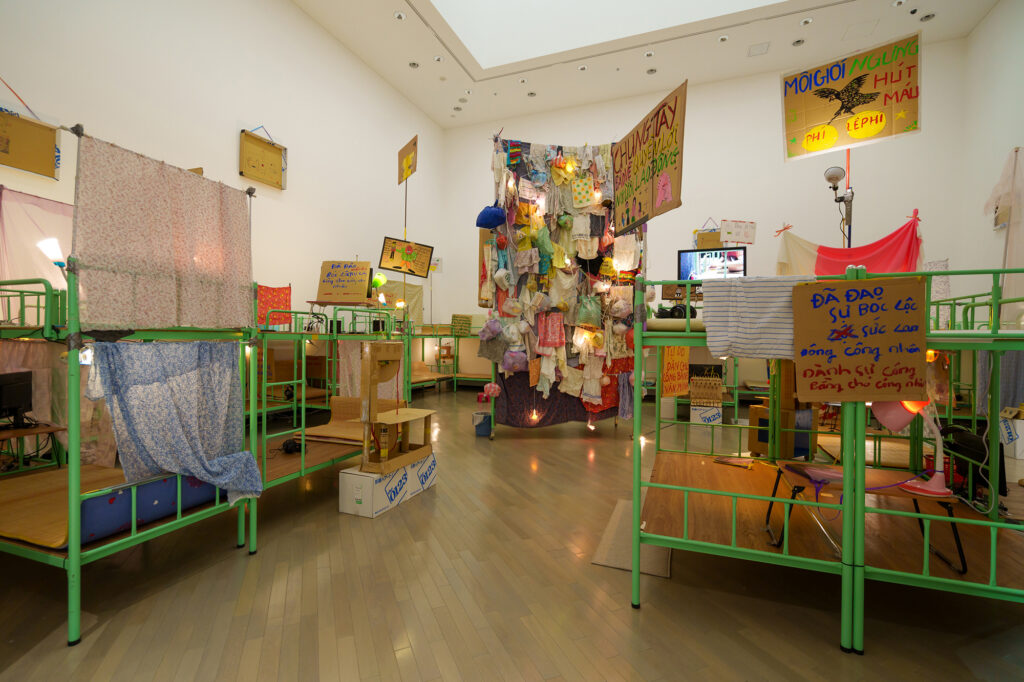
Your Bros. Filmmaking Group (SO Yo-Hen, LIAO Hsiu-Hui, TIEN Zong-Yuan), 宿舍 Ký Túc Xá/ Dorm, 2023/2024
This chapter is divided between Gallery 2 and Gallery 5. The title comes from the Japanese artist TOMIYAMA Taeko’s autobiographical essay My Liberation: Journey to the Frontier and the Bottom(1972).
Gallery 2 presents a video installation by Vienna-based artist NIWA Yoshinori and a new work, 宿舍 Ký Túc Xá / Dorm(2023/2024)by Your Bros. Filmmaking Group, a collective based in Tainan, Taiwan.
NIWA’s works attempt to expose the essence of the logic of capitalism by exaggerating or blurring it. By confronting NIWA’s works, we realize that we, too, have been successfully incorporated into the mechanisms that make the market economy run. ie relationship between the individual and the state is also based on the premise of protecting the order and interests of the state. How can we free ourselves from this?
Your Bros. Filmmaking Group’s work was inspired by the events of 2018, when more than 100 Vietnamese women workers went on strike in a dormitory in New Taipei City. News of this strike was spread around the world via the Internet. The work was created through many workshops and collaborations with people from different walks of life.
All the Rivers
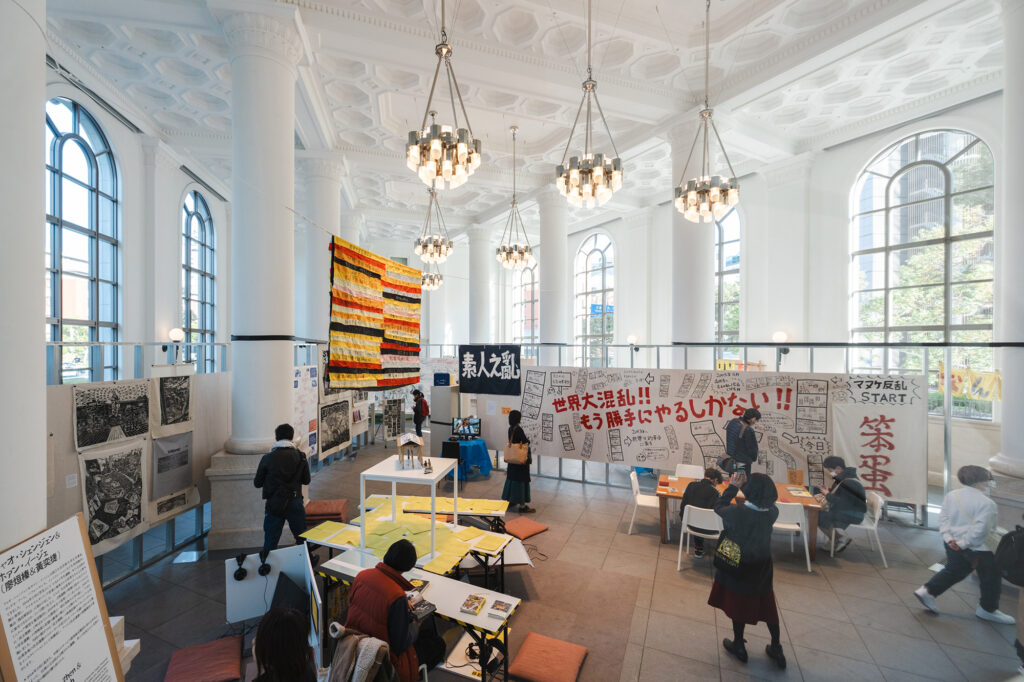
MATSUMOTO Hajime, Inter-Asia Woodcut Mapping Group, LIAO Xaun-Zhen & HUANG I-Chieh
The title of this chapter, which spans the former Yokohama branch of Daiichi Bank and BankART KAIKO, is taken from a novel All the Rivers(2014)by Israeli writer Dorit RABINYAN. The love story of two people, one from Israel and the other from Palestine, shows us how public events can affect individual lives.
What we present in the former Daiichi Bank building are the activities of people running cafes, second-hand clothing stores, low-cost lodging, printing shops, and radio stations that have been gaining momentum in East Asia over the past 20 years or so. Posting ideals such as “autonomy,” “mutual aid,” and “anti-consumerism,” they are trying to create spaces that are outside the reach of capitalist logic and the dominant social order, and to bring about social change in their daily lives. They also take to the streets to unite people and create new communities.
In addition, BankART KAIKO, across the street, introduces activities by people who have been trying to counter the worldwide movement in a direction prioritizing economies and neglecting the weak and disempowered since the 1990s with the end of the Cold War.
These practices call upon us to connect through our imagination and to bring revolutionary action into our daily lives, rather than simply waiting for a revolution to happen.
All the Rivers
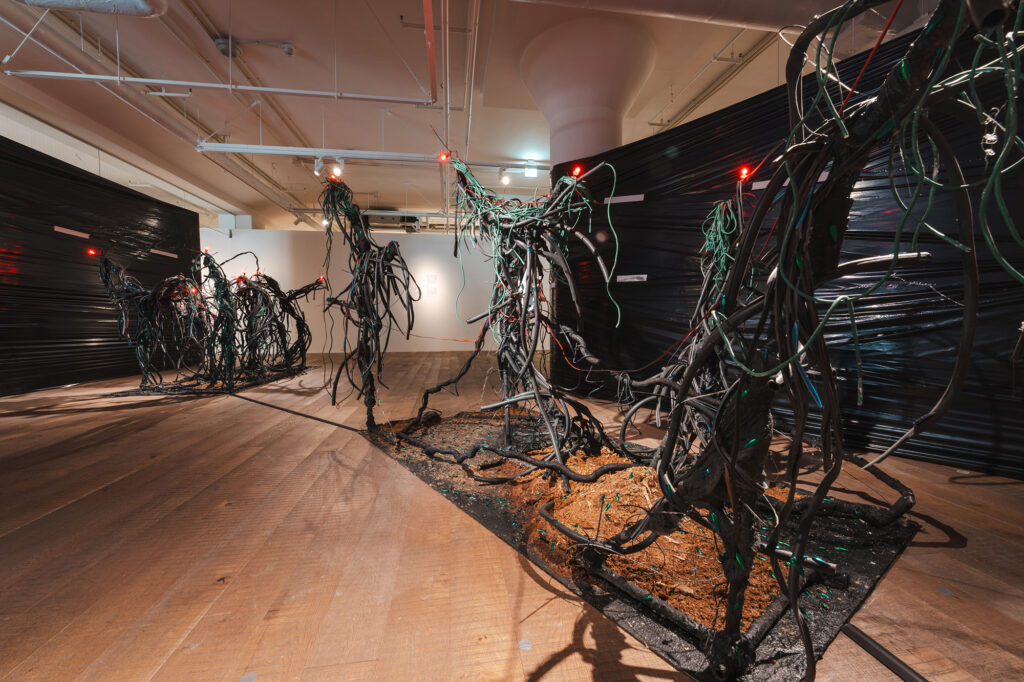
The title of this chapter, which spans two venues, BankART KAIKO and the former Yokohama branch of Daiichi Bank, is taken from a novel All the Rivers(2014)by Israeli writer Dorit RABINYAN. Thee love story of two people, one from Israel and the other from Palestine, shows us how public events can affect individual lives.
BankART KAIKO introduces the activities of people who have been trying to counteract the world’s capitalization since the 1990s with the end of the Cold War.
They create new social relations within a small space, and try to forge ties between these spaces that transcend differences in nationality, race, religion, and language. This brings to mind the way many small streams merge to form a large river.
In the background of this movement, we can see the attempts of thinkers such as Jacques DERRIDA and KARATANI Kojin to find a path that goes beyond capitalism by re-reading the writings of Karl MARX, the father of socialism.
Across the street at the former Daiichi Bank Yokohama Branch, visitors will be introduced to the activities of people who run cafes, second-hand clothing stores, lodging, and printing shops, and expand their networks in East Asia under the principles of “autonomy,” “mutual aid,” and “anti- consumerism.”


